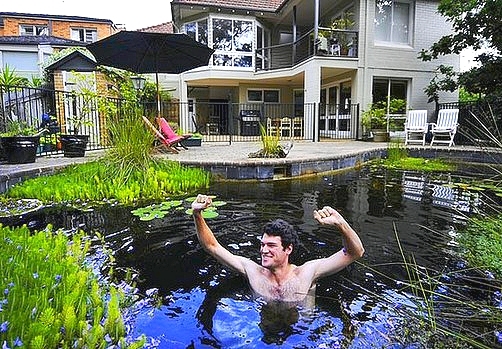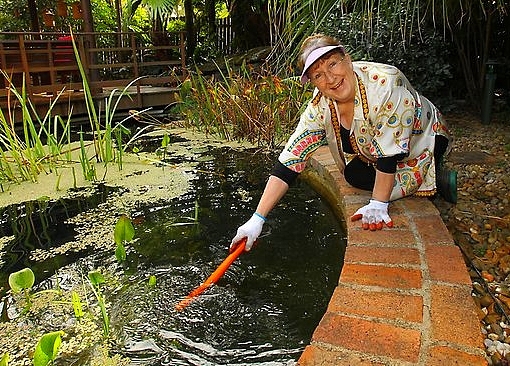Building a Backyard Pond by Converting Your Swimming Pool
This sounds a crazy idea but many people in Sydney Australia have made these conversions which are being promoted as part of the WildThings urban wildlife program developed by Ku-ring-gai Shire Council. The justification is that many swimming pools are not used very much when the kids get older and the owners find pools a real chore to maintain. Pool maintenance is also very expensive.
There are basically three main options: either fill it, let in go green and yucky in or transform it into something else. Pools are very expensive to remove. If you fill them in you may lose a lot of value if you decide to sell the property.
The good thing about converting the pool into a pond is that it keeps water in the pool and it is reversible. Sure it is a major cleaning job, but it can be done.
You can put the filtration system and pumps into mothballs, because if its done properly it will virtually look after itself. You can add native fish and frogs (some will find it themselves). The birds love it as well. Adding fish provides a natural way of controlling mosquitoes.
You can transform the surrounding decking and upgrade the landscape features to add shade and seating, so you can enjoy you new native pond. Adding a small water spout or a mini waterfall fills the backyard with the lovely sound of falling and splashing water. This helps to circulate water in the pond and keeps it aerated right to the bottom.
This article provides a step by step guide for transforming your backyard swimming pool into a delightful backyard pond.


Benefits of Converting a Swimming Pool to a Pond
- Turning off the filter and pool pump, and cost of chemicals can easily save you up to $1,000 a season. You also avoid the cost of repairs and replacements ( plus water costs in some localities).
- The conversion is reversible
- Water quality is generally well within official recreational waters standards (for creeks and lakes) and you an swim in it if you want to.
- Mosquitoes are not a problem provided you add some fish or a water fountain or waterfall to keep the water moving. Most mosquitoes only breed in shallow stagnant water and having a slight movement discourages them. Fish love to eat the larvae.
- Maintaining a pond is not expensive or time-consuming - almost nothing compared with a pool. You avoid all the daily and weekly time spend fiddling with the chemicals, cleaning the filters and removing leaves from the pool.
- You can promote biodiversity in your own backyard by adding water plants and fish. Local frogs will move in and birds will love it as well.
Questions and Answers about Converting Pools to Ponds
Will the pond water smell? Pond odor is not generally a problem once the pond ecology is established with the plants keeping the nutrient levels under control. The surface area of a pool is large and this makes sure that the water is kept well oxygenated. It is only stagnant water that smells. You can boost the aeration of deep ponds with an aquarium style aerator or a small pump for a fountain or waterfall. Just ensure that the inlet is drawn from the bottom of the pond. Huge reservoirs are kept circulating with simple aerators. Circulation stops the pool going stagnant which causes most smells.
Is the water safe? University tests have shown that the water in converted ponds meets Australian recreational water guidelines. The water is generally "clean" enough to swim in if that is what you want to do. But the water does not meet drinking water guidelines.
What about Safety Fences? Leave the fences in place and the gates secured, as the pond is just as much as a hazard as a pool.
Will a pond damage my pump and filter? Pumps and filters have limited life (10 years maximum) and will probably need to be replaced if and when you may want to convert the pond back into a swimming pool. You won't need them and so you should probably sell them. Keep the pump, or buy a fire-fighting style centrifugal pump for draining the pool for plant maintenance, and water rejuvenation. Filters and pool cleaners can be mothballed for later use.
Are Aquatic Plants necessary? Yes, plants are essential because plants act as natural filters and recycle nutrients that would otherwise feed algae (cause the water to go green and smell). Ideally aquatic plants will occupy about 50% of the pool's area. You may need to add structures on which the pots containing the plants can be placed. Leaving the plants on pots is a good idea because you can move them around an remove them when it comes time to restore the pond to a pool. Also the pots can contain the soil need for the plant roots. Many floating plants don't have roots. You can source suitable plants from your local pond supplier.
Does the pond ecosystem really keep the pool clean? Rigorous testing in the EU has shown that most of the many thousands of ponds that have been tested EU standards for both health and water clarity. Contamination from birds can make the water unhealthy.
Do You Need to Retain the a filter? No. This is not required as particulates tend to settled out and the water can be a little cloudy but still healthy.
If the pool turns green, will it stay that way? The pool may go green initially but will clear when the pond ecosystem is fully functional. You can buy various non toxic remedies for green pond water. Keep the pool scoop for removing leaves and dead pieces of algae and any rubbish that blows into the pool.
When can I add fish? Let the pool settle down for a while before adding fish. The best type are the local native fish which are fun to catch at your local stream of lake. You can also buy goldfish and other exotic species. The native fish may breed in the pond and become self sustaining. You can periodically add more fish to maintain the numbers. If you are really adventurous you can add trout fingerlings!
Key Steps for Converting your Swimming Pool into a Healthy Pond
Step I: Stop Adding Chlorine and Reduce Salt Concentration
If you stop adding chlorine, after a week or so, the pool will be ready for plants and fish. The chlorine in the pool may be toxic before then. Switch off the pump and filter and put them aside. The pump may be useful for draining the pool. If you have a salt water pool some or all of the water may need to be replaced as otherwise it may not be suitable for the fish and plants. Contact your local pond supply agent for advice. The salt water needs to be emptied down the sewer and not into storm water. Lowering the water level makes it easier to set up plants in the pool.
Step 2:The preliminary construction phase and addition of plants
Lower the pool level a little and make adjustments to the landscape surrounding the pool by adding rocks and boulders, pot plants to add shade. You can also add the plumbing for a waterfall or fountain. Adding a pond conditioner can also be a good idea. You also need to add plants to the pond in their pots. You can buy these from local nurseries of pond suppliers. Most plants need hallow water, so apart from placing them on the steps and shallow parts of the pond you will need to add some underwater framework or shelving to support the pots. This can be made out of plastic water pipe and fittings - with end caps left off to allow the water in. Putting a few stones on the base will kept it stead and upright. You can also water water-resistant timber or concrete black structure. Using plastic water pipe you can also make floating frames that can be pushed around into different parts of the pond. There are many floating species of plants that don't require roots in pots. Once established the plants will soon spread. You want 25-50% of the surface of the pond with some plant growth (not complete coverage).
Step 3: Islands and Submerged and Protruding Logs and Branches
Mini islands can be added to the pond using raft like structures made from timber with plastic water pipe used as floats. Adding logs and branches that protrude through the surface is good for insects and wildlife. Island and logs are not only attractive but provide refuges and structural diversity for wildlife.
Step 4:Tempering the Pool before Adding Animals
Once you are happy with the pool and you have added all the structures and plants, refill it with water and leave it for about one week to settle down. Run the aerator, fountain or waterfall pumps to help circulate the water. It is also a good idea to treat the new water with a pond conditioner to adjust the pH. Then it is time to add native fish caught in the local stream of lakes or goldfish. Always remember to allow the water containing the fish to gently adjust to the temperature of the pond before gently poring the fish in. Local children love to catch fish in local streams and rivers that can be added to the pond. They may also catch frogs and tadpoles to add to the pond. However frogs will generally find their own way to the pond during wet weather.
Step 5:Topping up the Water level
Rainwater is the best type of water to use, but standard reticulated water can also be used. If you need to add a large amount of tap water remember that the chlorine can kill plants and fish and so it is best to add a little at a time over several days.